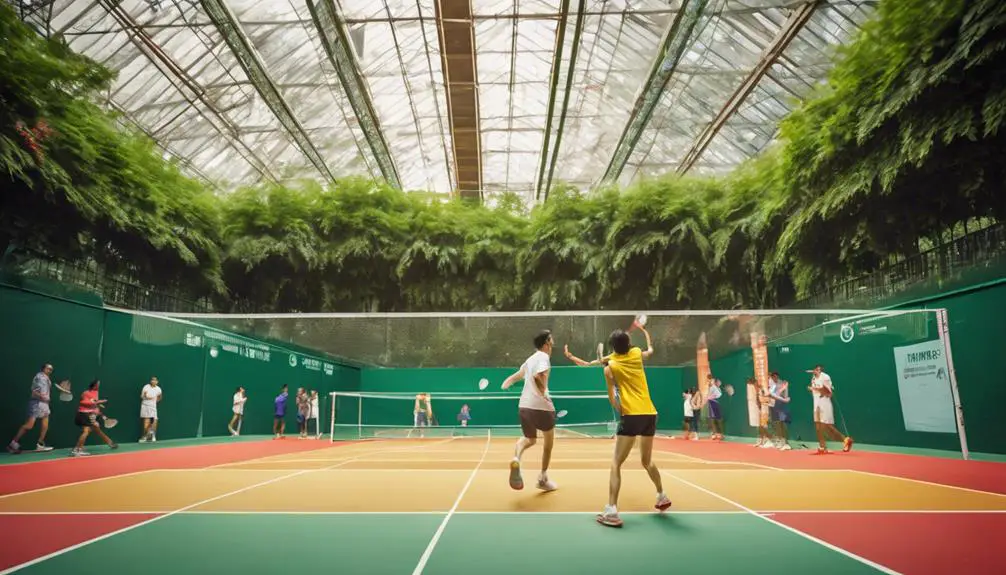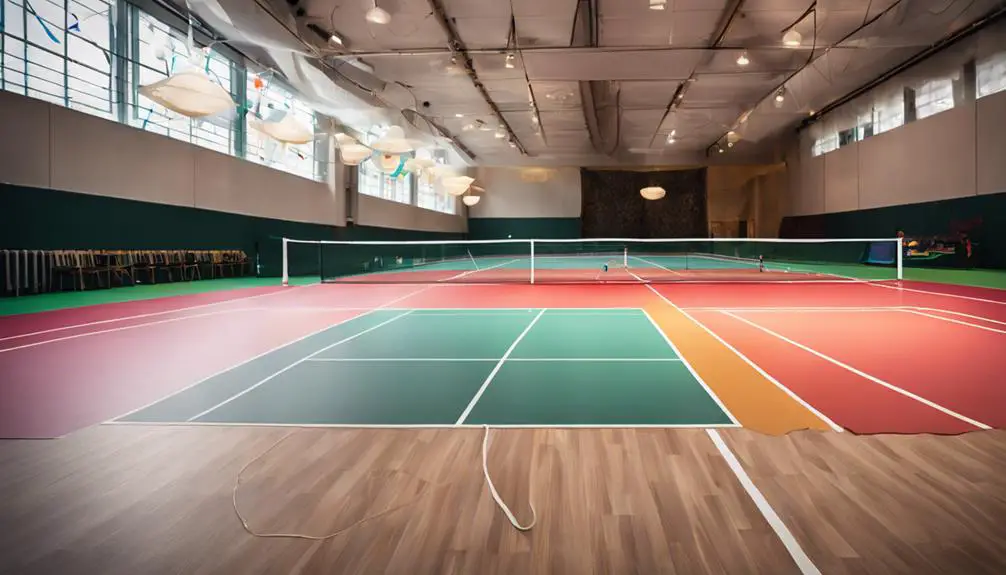When deciding between Speedminton and badminton, you’ll find distinct experiences in each sport. Speedminton is perfect for you if you enjoy casual play outdoors, with flexible rules and a focus on creativity. It uses sturdier rackets and heavier shuttlecocks, allowing fun matches almost anywhere. On the other hand, badminton is structured with precise techniques and a competitive spirit, played indoors with specific rules. Both sports offer great health benefits, but your choice should reflect your lifestyle and preferences. Explore deeper aspects of each sport, and you’ll uncover even more insights about their unique charm and community.
Overview of Speedminton

Speedminton, often touted as a modern twist on traditional badminton, offers a unique fusion of fast-paced action and accessibility. It’s a game that emerged in Germany in the late 1990s, designed to break free from the constraints of conventional badminton. With its history overview rooted in a desire for a more versatile and thrilling experience, Speedminton has quickly gained popularity worldwide.
One of the most compelling aspects of Speedminton is its adaptability. Unlike traditional badminton, which requires a net and specific court dimensions, Speedminton can be played almost anywhere—be it a park, a beach, or even a backyard. This freedom to play in diverse environments makes it appealing to casual players and athletes alike. The game variations are another key feature; you can choose from different formats, such as Speed Badminton, which emphasizes speed and agility, or the more relaxed version known as Night Speedminton, played with illuminated shuttlecocks.
These variations not only maintain engagement but also allow players to tailor their experience based on their preferences and skill levels. As you explore Speedminton, you’ll find that it encourages creativity and spontaneity, offering an invigorating alternative to structured sports. The game’s evolution reflects a broader trend toward inclusivity and flexibility in sports, allowing everyone to enjoy the thrill of competition without the traditional barriers. Whether you’re a seasoned athlete or just looking for a fun way to stay active, Speedminton opens the door to an exhilarating experience.
Overview of Badminton
Playing badminton has long been a cherished sport, known for its fast-paced rallies and strategic gameplay. The game’s history traces back to ancient civilizations, but it took shape in the mid-19th century as a formalized sport in England. With its origins rooted in the British military, badminton quickly gained popularity, evolving into a competitive sport played worldwide today.
To fully appreciate badminton, you need to understand some key aspects:
- Game Structure: Badminton can be played in singles or doubles formats, allowing players to showcase their skills in various ways. Each match is divided into sets, with the first player or team to reach 21 points winning the game.
- Techniques: Mastering badminton techniques is essential for success. You’ll often hear about footwork, serves, smashes, and drops—each plays a significant role in your overall performance. Understanding how to execute these techniques can give you an edge over your opponents.
- Fitness and Strategy: Beyond skills, badminton demands physical fitness and mental strategy. Players must maintain stamina, agility, and quick reflexes while also anticipating opponents’ moves, making it a game of both body and mind.
Whether you’re a casual player or aspiring to compete, diving into badminton history and techniques enriches your experience. So, grab a racket and embrace the freedom this dynamic sport offers!
Key Equipment Differences

Understanding the nuances of badminton equipment is vital for grasping the differences between it and Speedminton. First off, let’s talk about racket types. In badminton, you’ll typically find rackets designed for precision and control, often made from lightweight materials like carbon fiber. Speedminton rackets, on the other hand, are generally sturdier to handle the heavier speed shuttlecocks used in the game.
Now, regarding shuttle differences, badminton uses feather shuttles that are more delicate and require calm conditions for ideal play. Speedminton employs a heavier, plastic shuttlecock that can withstand wind, making it perfect for outdoor play. This distinction greatly impacts how each game is played and the strategies involved.
Court dimensions are another important difference. A standard badminton court measures 20 feet wide by 44 feet long for doubles, while Speedminton courts can vary in size, often being more flexible to accommodate different settings. This flexibility can give you more freedom to set up your game, whether it’s in a park or on a beach.
Lastly, consider player gear and game accessories. In badminton, specialized shoes and clothing are vital for movement and grip, while Speedminton allows for more casual attire since it’s often played in informal settings. Knowing these key equipment differences not only enhances your understanding of both games but also helps you choose the right gear for your playing style and environment.
Rules and Scoring Systems
When comparing the rules and scoring systems of badminton and Speedminton, it’s clear that each game has its own unique framework that shapes how they are played. Understanding these differences can enhance your experience and strategy, whether you’re looking to dominate on the court or just have fun with friends.
- Service Rules: In badminton, the service must be executed diagonally, and the server must strike the shuttlecock below their waist. In Speedminton, however, there’s more flexibility, as players can serve from anywhere in the playing area, which can lead to more creative shots.
- Scoring Variations: Badminton employs a rally scoring system, where points can be won by either the serving or receiving side, with matches typically played to 21 points. Speedminton also uses rally scoring but allows games to be played to 11, 16, or 21 points depending on player agreement, giving it a more adaptable structure.
- Match Length: Badminton matches are played in best-of-three formats, while Speedminton can adapt based on player preference, allowing for shorter or longer games. This can create a more relaxed atmosphere, perfect for casual play.
These rules and scoring systems not only define each sport but also influence gameplay dynamics. By grasping these elements, you can better appreciate the strategic depth of both badminton and Speedminton, making your playtime more enjoyable and engaging.
Playing Environment and Conditions

The differences in rules and scoring systems lead to distinct playing environments and conditions for badminton and Speedminton. In badminton, you typically find yourself on a specific court surface, usually indoors, which can be essential for ideal player movement. The game’s duration, often longer due to its rally-based scoring, means you might be playing in a more controlled climate, free from unpredictable weather conditions.
On the flip side, Speedminton thrives in a more versatile setting. It’s designed to be played outdoors, allowing you to embrace the elements and enjoy social activities with friends. The equipment’s portability is a game-changer; you can easily set up a match anywhere, from a park to the beach, without the constraints of traditional court setups. This flexibility encourages spontaneous play, aligning perfectly with those who value freedom and casual competition.
While badminton requires adherence to specific indoor conditions, Speedminton’s adaptability opens doors to various environments. This adaptability influences player movement as well. In badminton, you’ll likely need to be more strategic within the confines of the court, whereas in Speedminton, the open space can lead to a more fluid, dynamic style of play.
Ultimately, whether you’re engaging in a friendly match or competing, the environment shapes your experience. Badminton’s structured, competitive settings contrast with the liberating, informal nature of Speedminton, catering to different player preferences and lifestyles.
Styles of Play
One key difference in styles of play between badminton and Speedminton is how each game emphasizes various skills and strategies. In badminton, the fast-paced nature and the use of a net require a blend of offensive strategies and defensive tactics. You’ll find that players often engage in quick exchanges, utilizing finesse and precision to outmaneuver their opponents. The rallies can become intensely strategic, as players need to anticipate their rival’s moves while adapting their own.
On the other hand, Speedminton offers a more dynamic playing style, emphasizing power and speed. The absence of a net changes the game’s dynamics altogether, allowing for a broader range of offensive strategies. You’ll notice that players often use hard hits and long-distance strikes to keep their opponents on the back foot. This requires a different mindset, focusing on aggressive play and quick footwork.
Here are three key aspects to take into account regarding the styles of play in both games:
- Offensive Strategies: Badminton players rely on net play and angled shots, while Speedminton players focus on powerful, long-range strikes.
- Defensive Tactics: In badminton, anticipating the shuttle’s trajectory is essential; in Speedminton, positioning and swift reactions are critical to counter fast-moving speeder.
- Pacing and Rhythm: Badminton emphasizes controlled pacing, whereas Speedminton promotes a more frenetic rhythm, often leading to exciting exchanges.
Understanding these styles can help you appreciate the unique elements each game brings to the table.
Health Benefits of Each Sport

Engaging in either badminton or Speedminton offers a range of health benefits that can enhance your physical and mental well-being. Both sports provide an excellent cardiovascular workout, improving your heart health and increasing your endurance training capabilities. As you dart around the court, you’re not just having fun; you’re also building muscle strength and enhancing your coordination skills.
Here’s a quick comparison of the health benefits of each sport:
| Benefit | Badminton | Speedminton |
|---|---|---|
| Cardiovascular Fitness | High-intensity play | Constant movement |
| Muscle Strength | Upper body focus | Full-body engagement |
| Flexibility Improvement | Various strokes | Dynamic movements |
| Stress Relief | Social play | Fast-paced action |
Both sports also offer significant flexibility improvement, with badminton requiring a variety of lunges and stretches, while Speedminton’s fast-paced nature encourages agile movements. One of the fantastic aspects of playing these sports is the social interaction they foster. Whether you’re on a court or a beach, the camaraderie helps ease stress and promotes mental agility.
Ultimately, whichever sport you choose, you’ll find that the combination of physical activity and social engagement contributes to your overall health. So, grab your racket and start enjoying the myriad benefits that badminton or Speedminton has to offer!
Popularity and Accessibility
With millions of players worldwide, both badminton and Speedminton have carved out their unique spaces in the sports arena. While badminton boasts a rich history and an established global community, Speedminton is making strides in accessibility and innovation. You might find yourself drawn to one over the other based on various factors including community involvement and available youth programs.
Here are three key aspects to take into account:
- Accessibility: Speedminton can be played almost anywhere since it doesn’t require a court or net. You can set up a game in a park, on a beach, or even in your backyard. Badminton, on the other hand, often requires specific equipment and facilities, which can be a barrier for some players.
- Community Involvement: Both sports have active communities promoting involvement. Badminton clubs often host tournaments and training sessions, while Speedminton encourages informal play and social gatherings, making it easier for newcomers to join.
- Youth Programs: Many organizations are introducing youth programs for both sports. Badminton has well-established youth leagues and school programs, while Speedminton is rapidly gaining popularity among younger audiences due to its easy setup and emphasis on fun.
Choosing the Right Sport

When considering which sport to pursue, personal preferences and circumstances play a significant role. For those who enjoy a fast-paced, dynamic environment, Speedminton might be your go-to option. It emphasizes quick reflexes and agility, allowing for a unique blend of skill development and spontaneity. If you thrive in outdoor settings and desire flexibility in your playing environment, Speedminton offers that freedom, letting you set up games anywhere.
On the other hand, if you favor a more structured approach with established rules, badminton could be the right fit. The sport’s focus on game strategy and technique allows for deeper tactical thinking and skills. Badminton courts are often found in gyms, making it accessible year-round, regardless of the weather. This sport requires precision and finesse, catering to those who enjoy mastering complex techniques over time.
Ultimately, your choice hinges on what you value in a sport. Are you looking for an intense, casual game that can adapt to various environments? Or do you prefer the disciplined nature of traditional badminton, where every match is a test of strategy and skill? Both sports offer unique avenues for physical activity and personal growth. Think about how each sport aligns with your lifestyle and goals. The right choice will not only enhance your enjoyment but also foster your development as an athlete, ensuring you find fulfillment in your sporting pursuits.
Frequently Asked Questions
Can Speedminton Be Played Indoors or Outdoors?
You can definitely play speedminton both indoors and outdoors. Indoor surfaces like gym floors offer a controlled environment, while outdoor venues provide an exhilarating open-air experience. Each setting brings its own unique challenges and enjoyment.
What Are the Primary Differences in Player Movements Between Both Sports?
In analyzing player movements, you’ll notice court dimensions affect your positioning. Badminton emphasizes quick footwork and precise stroke techniques, while Speedminton encourages a more dynamic style, allowing you to explore movement with greater freedom and creativity.
How Do Weather Conditions Impact Speedminton Gameplay?
When the wind howls like a restless spirit, it plays tricks on your shot. You’ll notice wind resistance alters your strategy, while different court surfaces affect your grip and agility, shaping your gameplay in unpredictable ways.
Are There Professional Speedminton Tournaments Like in Badminton?
Yes, there are professional tournaments for speedminton, along with competitive leagues that promote the sport. These events allow players like you to showcase skills, engage with others, and enjoy the thrill of competition in a dynamic environment.
What Age Groups Typically Participate in Speedminton?
You’ll find speedminton attracts a wide range of age groups due to its growing popularity and accessibility. From kids to adults, everyone can enjoy this dynamic sport, making it a fantastic choice for active individuals.




